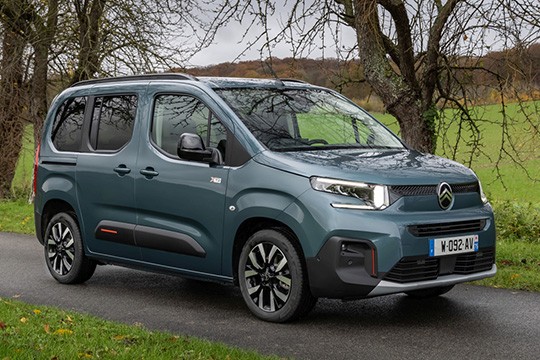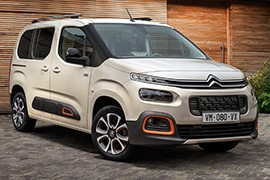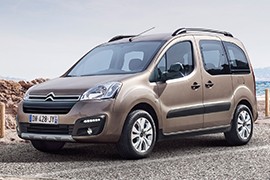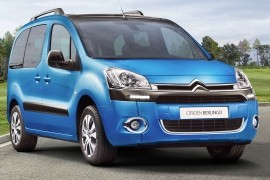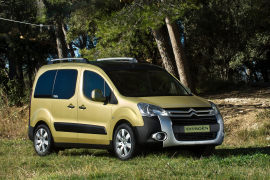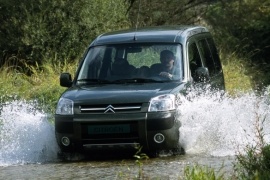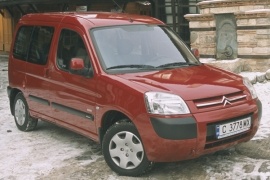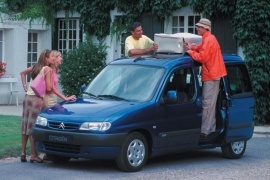CITROEN Berlingo Models/Series Timeline, Specifications & Photos
First production year: 1996
Engines: Gasoline, Diesel, Natural gas
Body style: Van
Citroën refreshed the third generation of the Berlingo MPV in late 2023 for the 2024 model year, improving the family-friendly vehicle in most areas and offering it with an electric powertrain.
The French automaker introduced the third generation of the Berlingo in March 2018, offering it with a choice of diesel and gasoline engines. Almost three years later, in January 2021, the vehicle received an electric powertrain that helped the brand join the EV revolution. The Berlingo shared its underpinnings with the Peugeot Partner, the Opel Combo, and the Toyota ProAce City. Furthermore, Fiat also made the Doblo based on the same platform and offered it to customers starting in 2022. In 2023, Citroën introduced the facelift for the Berlingo and charged with all the engines available, including the electric version.
In 2022, Citroën introduced its new logo that mimicked the original one from 1919 and applied it to the refreshed Berlingo, along with a new front fascia. The angular shapes of the upper grille were flanked by the straight lines that formed the LED daytime running lights. Lower, the fat bumper sported a main air intake in the central area of the apron and two side scoops that sported the fog lamps. Like on its predecessor, the lower side of the bumper was left unpainted to diminish repair costs if scratched.
From its profile, the 2024 Berlingo showed a similar look as its predecessor, albeit it was available with new 16-inch or 17-inch alloy wheels. A black plastic molding was present on the front doors and extended over the rear, sliding ones. Even if it wasn’t the most economical solution, Citroën kept the same system since it was more practical. At the back, the ë-Berlingo featured corner-mounted taillights that flanked the wide tailgate, which, in turn, was adorned by a roof spoiler on its upper side. The rear bumper was also black on its lower side and body-colored on the upper side.
Inside, Citroën installed bolstered, high-mounted seats for the front occupants. These improved the comfort for their occupants and provided better side support during high-speed cornering, even though the Berlingo was not the kind of car to be driven fast on a winding road. Like its predecessor, the refreshed minivan was available in two length versions, offering either five in two rows or seven in a three-row configuration. The touchscreen for the infotainment system sat atop the center stack and featured wireless Apple CarPlay and Android Auto. Citroën offered the ë-Berlingo with an opening rear window, allowing easier access to the trunk.
Under its hood, the ë-Berlingo featured a 100 kW motor that sent its power to the front wheels only. It was fed by a 50 kWh LFP battery, allowing the vehicle to run seamlessly up to 320 km (200 miles). The 2024 ë-Berlingo could be recharged via a 7 kW charger or via an onboard system.
The third generation of the Citroen Berlingo was released in 2018 and came with big improvements across the range. From the utilitarian vehicle adapted for passenger transportation it became a true MPV without forgetting its roots as a compact utility vehicle.
It still has the same shape with a high roof and sliding doors on the side, but it doesn't look like it belongs to a warehouse anymore. The French stylists made it with short overhangs and a high front profile, like an SUV. It can be fitted with Xenon headlights and has standard LED daytime running lights (DRL).
Taking their inspiration from the world of furniture and travel, the designers developed the interior of new Berlingo to be functional and high quality. They used soft-touch and warm materials to make occupants feel good. The interior is available with new trim and a varied set of colors corresponding to several interior ambiances.
Since the platform is the same as the one from the Peugeot 308 passenger car, the ride is smoother. The available engines are a 1.2-liter gasoline engine with 110 hp mated to a 6-speed manual gearbox and another 1.2-liter turbo with 130 hp mated to an 8-speed automatic transmission. For diesel fans, there is also a 1.5 liter in three outputs versions: 75 hp, 100 hp, and 130 hp, respectively. The latter can be mated to an 8-speed automatic gearbox. The others have a 6-speed manual.
We first heard the name of Berlingo in 1996, with the launch of the Citroen’s first model.
24 year later, the Berlingo still satisfied the customer’s needs and Citroen came with a face-lifted version.
Launched at the 2015 Geneva Motor Show, the Berlingo offered the same versatility and practicality it’s used us with. The front was refreshed with a new bumper and redesigned headlights with LED, plus a new grille. Users were given two extra colors to choose from for the exterior paint: Acier Grey and Moka Brown.
The Berlingo was available in 2 different variants. The Multispace version designed for families and the LCV for cargo.
The first one mentioned was a great asset for bigger families and comfortable trips. Sliding doors were used to ease access, as well as a big tailgate that facilitated loading big luggages. Additionally, users could open only the glass part of the tailgate to pick small things from the trunk.
The interior offered no luxury and of course, it was not designed with this purpose. However, it was very roomy and practical. The base trim level offered electric windows, ABS and ESP.
The LCV version had a maximum payload of 896 kg.
No matter the variant, the Berlingo held the road well with its high center of gravity.
So if you’re looking for a family budget car or a simple and inexpensive utility van, the Berlingo should satisfy all needs.
The Berlingo was the Citroen version for the Peugeot Partner, but with a slightly different design.
While the MPV market was crashing, the French carmakers didn't want to give up so quickly. They found a way to cut the development and manufacturing costs by making an MPV based on an LCV. The recipe was followed by other carmakers such as Opel, Fiat, or Volkswagen.
In 2008, Citroen introduced the second generation for the Berlingo and refreshed-it in 2012 with a major facelift. The front grille featured two slats that converged into the Citroen's badge, named "double-chevron." In the upper side of the bumper, the designers installed a set of daytime running lights, which became mandatory according to 2012 regulations. In the rear, the vertically mounted taillights received clear lenses and a different look.
Inside, it was hard for anyone to complain about the car's roominess. Due to its high greenhouse, the designers could install higher seats and allowed enough legroom even for tall passengers. In the back, the carmaker installed three individual seats as an option, and all three of them could have been folded individually or completely removed if there was a need for a larger cargo area.
Under the hood, Citroen installed a new engine range with a similar 1.6-liter displacement. All of them were paired to a 5-speed manual. A 6-speed automatic was offered as an option for selected versions.
Citroen chose an interesting way to produce a small MPV that was available as a light-utility vehicle as well: it opted for a passenger car platform.
While the MPVs were not so popular in Europe anymore, the French car-maker Citroen/Peugeot thought that offering a family car in an LCV body-shape would do great for those who are using a car in both directions. And that's how the Citroen Berlingo Multispace and Peugeot Partner was made. The PF2 platform was used for the first time in the compact-car Peugeot 307.
The look might have not been its strongest advantage, but it was built to form a spacious vehicle. With a raked front fascia, an almost vertical A-pillar, and a high roofline, the Berlingo Multispace had the shape of a light utility vehicle. The sliding rear doors were taken from the same vehicle, that eased the loading and unloading. A flat and vertical rear end abruptly ended the vehicle.
Inside, there was a cavernous space with a lot of headroom. The flat floor allowed an unobstructed passage from one side to the other, via the sliding doors. The high driving position and the dashboard were made to fit a daily job as a delivery van. With the rear seats that could have been reclined, the comfort was good. If there was a need to transport bulky items, the rear seats could have been folded or completely removed. It was available with a 7-seat option.
Under the hood, the most obvious engine was a 1.6-liter diesel unit mated to a 6-speed manual. The in-dash, high-mounted gear-stick was easy to use and practical since it eased the move inside the cabin from left to right.
Following the successful launch of the C3 X-TR, the French carmaker introduced an X-TR version for its MPV Berlingo in 2006.
One of the cheapest ways to make a minivan was to build it on the same platform as a light-utility vehicle. Citroen used that recipe and made the Berlingo either as a van or a passenger vehicle (named Berlingo Multispace) since 1996, with a significant facelift in 2003. But the customers started to get more focused on leisure vehicles, crossovers, and SUVs. Then, Citroen came with a unique package that transformed the daily-driver family van into a crossover.
Sure, the car was not a serious off-road vehicle. It didn't feature an all-wheel-drive system, but at least it could look like it was ready for some unpaved roads. At the front, the carmaker added a light-gray shield under the bumper and placed similar colored trims around the fog lights. A larger, rectangular grille with a wide horizontal slat left the impression of a bush-guard. Under the large headlights, the carmaker added scratch-resistant black plastic moldings.
Inside, there were minor changes from the full-spec Berlingo. It featured circular silver air vents and light-gray trims on the dashboard and door cards. The light-gray dials in the instrument cluster sported white needles. Thanks to its high roof cabin, Citroen installed a shelf above the driver area and side pockets above the rear sliding doors. For the rear passengers, the carmaker installed folding tables on the back of the seatbacks of the front seats.
Citroen-Peugeot introduced the Berlingo/Partner duo in 1996 as a light commercial vehicle mostly for the European market and refreshed the lineup in 2002.
Citroen built the Berlingo Multispace as a light commercial vehicle, and then it transformed it into a people carrier. In 2002, Europe switched to Euro 3 emission standards for LCV, and that allowed the French carmaker to postpone the introduction of new engines in the Berlingo. Along with the new powertrains, it made some other exterior adjustments.
Although the non-facelifted version featured slim appreciated headlights, the designers changed them with a pair of bigger ones to improve visibility. That led to a complete change o the front fascia, including the bumper, front fenders, and hood. But the design team considered that they did enough for the exterior and left the rest of the car unchanged.
Inside, the 2002 Berlingo featured a new dashboard design, with round air-vents instead of squared ones. The instrument cluster was shorter and allowed a taller center stack with an additional display on top of the dash panel. Depending on the trim level, the car featured an audio system and air-conditioning. Like its non-facelifted version, the 2002 Berlingo offered five seats, with the removable back ones to increase the cargo area.
But the most important change was under the hood, where Citroen installed new or updated engines. It was designed more as a utility vehicle, and it featured two gasoline and four diesel engines. For fleets, the French carmaker offered a 1.4-liter CNG version.
Citroen was one of the most important light utility vehicles on the French market and the 1947 H Van, which was a great success for the double-chevron company.
While the U.S. used the pickups as work or family cars, the Europeans chose the LCV's based on car platforms, such as the Berlingo. These were the MPVs suitable for everyone's needs. They were good as grocery getters, school runs, and leisure vehicles thanks to their flat platform behind the front seats, which was also used as a sleeping area.
The Berlingo shared most of its body panels with the Peugeot Partner. Its family-cars inspired its narrow headlights and grille. Citroen offered a standard rear side sliding door on the passenger's side and offered an option for a second one on the driver's side. In the back, the wide and tall tailgate ensured an easy-to-load cargo area, which could have been loaded with a forklift.
Inside, the big windows offered a fish-tank experience and excellent visibility for the driver with very little blind-spots. The tall seats and wide cabin offered room for five adult-sized passengers. With its removable or just folding second-row of seats, the Berlingo offered a huge interior space for cargo. At the front, the carmaker installed a car-like dashboard with a flow-like instrument cluster.
Under the hood, Citroen offered a choice of six engines, depending on the market. The most desired option was the five-speed manual 2.0-liter turbo-diesel unit, which provided the best fuel-efficiency.
